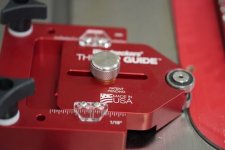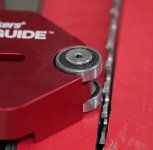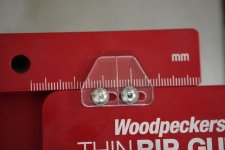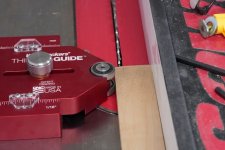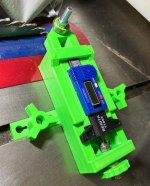HowardH
Member
I like to make projects using thin strips and was never comfortable getting the table saw fence within a couple of mm of the blade. I could always use my band saw but it's not very accurate and it would require me to run it through the drum sander to get it to the final thickness. I saw this advertised several months ago and decided to give it a try. I have several other WP tools and have for the most part found them worth the money. I had forgotten about ordering it and it showed up in the mail couple of days ago. My initial impressions is that this follows the pattern that woodpecker provides, meaning it's a very well made, heavy, high-quality tool.
[attachimg=1]
It requires a standard three-quarter inch miter slot and has these hexagonal nuts that slide right in and are tightened by a knob on each side.
[attachimg=2]
Once it's tightened down, it is rock solid. The first thing you have to do is set up the plastic scale indicators. That is accomplished by loosening the centerpiece with the big knob and sliding the bearing to where it just touches the blade tooth.
[attachimg=3]
Then you tighten down the center knob and slide the indicator over until it's centered on the closest major mark. It does have both metric and imperial scales which is a nice touch because I use both systems in my projects.
[attachimg=4]
At that point, it's fully calibrated and ready for use. The first thing you have to do is slide the unit toward you so it's a couple of inches in front of the blade. Then, you simply loosen the main nut and slide the centerpiece with the bearing back using the scale to get your desired offcut. In this example, I used 5 mm.
[attachimg=5]
From there, all you have to do is move your fence with the stock until it just touches the bearing and then tighten the fence and begin to rip away! Each offcut is exactly the same. You can go out a couple of inches if you needed to but I think as long as I can safely get a push stick between the blade in the fence, I won't need to go that far.
[attachimg=6]
I can see using this quite a bit, especially when I'm doing my cutting boards. Again, it's not cheap, but neither are Festools and there's no question that we all share the value of buying quality. It's like the old saying goes, "buy once and cry once!" If you do a lot of thin ripping, it's definitely worth taking a look at.
[attachimg=1]
It requires a standard three-quarter inch miter slot and has these hexagonal nuts that slide right in and are tightened by a knob on each side.
[attachimg=2]
Once it's tightened down, it is rock solid. The first thing you have to do is set up the plastic scale indicators. That is accomplished by loosening the centerpiece with the big knob and sliding the bearing to where it just touches the blade tooth.
[attachimg=3]
Then you tighten down the center knob and slide the indicator over until it's centered on the closest major mark. It does have both metric and imperial scales which is a nice touch because I use both systems in my projects.
[attachimg=4]
At that point, it's fully calibrated and ready for use. The first thing you have to do is slide the unit toward you so it's a couple of inches in front of the blade. Then, you simply loosen the main nut and slide the centerpiece with the bearing back using the scale to get your desired offcut. In this example, I used 5 mm.
[attachimg=5]
From there, all you have to do is move your fence with the stock until it just touches the bearing and then tighten the fence and begin to rip away! Each offcut is exactly the same. You can go out a couple of inches if you needed to but I think as long as I can safely get a push stick between the blade in the fence, I won't need to go that far.
[attachimg=6]
I can see using this quite a bit, especially when I'm doing my cutting boards. Again, it's not cheap, but neither are Festools and there's no question that we all share the value of buying quality. It's like the old saying goes, "buy once and cry once!" If you do a lot of thin ripping, it's definitely worth taking a look at.

